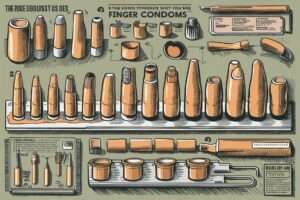Finger Condoms: A Comprehensive Guide to This Versatile Protection Method
Ever heard of finger condoms? These small, often overlooked protective devices are more useful than you might think. Whether you’re exploring safer sex practices, looking for protection during medical procedures, or seeking a solution for minor injuries, finger condoms could be just what you need.
In this comprehensive guide, we’ll dive deep into the world of finger condoms, exploring their uses, benefits, and how to use them effectively.
Condoms and STDs: Understanding Protection and Limitations

Table of Contents
ToggleWhat Are Finger Condoms?
Finger condoms, also known as finger cots or toe protectors, are small, finger-shaped sheaths designed to cover a single finger. They’re typically made from latex, nitrile, or other flexible materials, similar to regular condoms but sized for fingers. These versatile little protectors come in various sizes to fit different finger lengths and widths.
Giardiasis: Understanding, Preventing and Treating the “Beaver Fever”

The History and Evolution of Finger Condoms
While the exact origin of finger condoms is unclear, they’ve been used in various industries for decades. Initially popular in medical and food service settings, finger condoms have gradually found their way into sexual health practices and other personal uses. Over time, manufacturers have improved the materials and designs, making them more comfortable and effective for a wider range of applications.
Pubic Lice (Crabs): Symptoms, Diagnosis and Treatment
Uses of Finger Condoms
Finger condoms serve a variety of purposes across different fields:
1. Sexual Health:
– Protection during digital penetration
– Barrier for oral sex involving fingers
– Safe exploration for partners with different STI statuses
2. Medical and Dental:
– Protecting cuts or wounds on healthcare workers’ fingers
– Maintaining hygiene during examinations
– Preventing contamination in dental procedures
3. Food Service:
– Maintaining food hygiene when handling ingredients
– Protecting against cuts and burns in the kitchen
4. Personal Care:
– Covering cuts or injuries on fingers
– Protecting fingers during arts and crafts projects
– Keeping fingers dry when applying creams or ointments
Is Scabies an STD? Understanding the Facts About This Contagious Skin Condition
5. Industrial and Laboratory Use:
– Protecting fingers from chemicals or other harmful substances
– Maintaining clean environments in sensitive lab work

Benefits of Using Finger Condoms
1. Hygiene: They create a barrier against bacteria and other microorganisms.
2. Protection: They shield fingers from cuts, chemicals, and other potential hazards.
3. Versatility: Useful in various settings, from medical to personal care.
4. Comfort: Less cumbersome than wearing full gloves for single-finger tasks.
5. Cost-effective: Generally cheaper than full gloves for tasks requiring protection on one or two fingers.
How Long Does It Take for Chlamydia to Show Up? Understanding the Timeline and Symptoms
How to Use Finger Condoms?
Using a finger condom is straightforward, but proper technique ensures maximum effectiveness:
1. Choose the right size: Finger condoms come in various sizes. Select one that fits snugly without being too tight.
2. Check for damage: Inspect the finger condom for any tears or holes before use.
3. Roll it on: Carefully roll the finger condom onto the desired finger, much like you would a regular condom.
4. Ensure proper coverage: Make sure the finger condom covers the entire finger, including the tip.
Trichomoniasis: Understanding, Preventing and Treating this Common STI
5. Replace as needed: For hygiene purposes, use a new finger condom for each new activity or partner.
6. Dispose properly: After use, carefully remove the finger condom and dispose of it in the trash. Don’t flush it down the toilet.

Types of Finger Condoms
1. Latex Finger Condoms:
– Most common type
– Highly elastic and durable
– Not suitable for those with latex allergies
2. Nitrile Finger Condoms:
– Latex-free alternative
– Resistant to many chemicals
– Suitable for those with latex allergies
3. Vinyl Finger Condoms:
– Another latex-free option
– Less elastic than latex or nitrile
– Often used in food service industries
4. Polyethylene Finger Condoms:
– Thinner and less durable
– Often used for short-term or disposable applications
Finger Condoms vs. Full Gloves
While full gloves have their place, finger condoms offer several advantages in certain situations:
1. Precision: Allow for greater dexterity and sensitivity in tasks requiring fine motor skills.
2. Convenience: Easier to put on and take off quickly.
3. Resource Conservation: Use less material when only one or two fingers need protection.
4. Comfort: Less sweating and skin irritation compared to full gloves, especially in warm environments.
However, full gloves are preferable when protection for the entire hand is necessary or when dealing with highly hazardous materials.
Finger Condoms in Sexual Health
In the context of sexual health, finger condoms play a crucial role in safer sex practices:
1. STI Prevention: They create a barrier that can help prevent the transmission of sexually transmitted infections (STIs) during digital penetration or stimulation.
2. Hygiene: Useful for maintaining cleanliness during sexual activities, especially when transitioning between different areas of the body.
3. Comfort: Can provide a smoother sensation for the receiving partner, especially if the wearer has rough skin or long nails.
4. Accessibility: Offer a safer sex option for those who may not be comfortable with or able to use traditional condoms.
According to a study published in the journal Sexually Transmitted Infections, consistent use of barriers like finger condoms during sexual activity can significantly reduce the risk of STI transmission.
Where to Find Finger Condoms
Finger condoms are available from various sources:
1. Pharmacies and Drug Stores: Often found in the first aid or sexual health sections.
2. Medical Supply Stores: Typically stock a variety of sizes and materials.
3. Online Retailers: Offer a wide selection and the convenience of home delivery.
4. Sexual Health Clinics: May provide finger condoms for free or at a low cost.
Tips for Choosing and Using Finger Condoms
1. Check the material: If you have latex allergies, opt for nitrile or vinyl options.
2. Consider the task: Choose thicker, more durable cots for tasks involving chemicals or sharp objects.
3. Proper storage: Store finger condoms in a cool, dry place away from direct sunlight to maintain their integrity.
4. Use lubricant wisely: If using lubricant with finger condoms, ensure it’s compatible with the material to prevent degradation.
5. Don’t reuse: Finger condoms are designed for single use only. Always use a fresh one for each new activity.
Common Misconceptions About Finger Condoms
1. “They’re only for medical use”: While commonly used in healthcare, finger condoms have many applications beyond medical settings.
2. “They’re not effective for STI prevention”: When used correctly, finger condoms can be an effective barrier against many STIs.
3. “They’re too small to matter”: Even small barriers can make a significant difference in preventing the spread of bacteria and viruses.
The Future of Finger Condoms
As awareness of sexual health and hygiene continues to grow, we may see further innovations in finger condom design and materials. Some potential developments could include:
1. Smart materials that change color when exposed to certain pathogens
2. Biodegradable options for more environmentally friendly disposal
3. Enhanced textures for better grip and sensitivity
Conclusion
Finger condoms may be small, but their impact on health, hygiene, and safety across various fields is significant. Whether you’re a healthcare professional, food service worker, or someone looking to practice safer sex, finger condoms offer a versatile and effective solution for finger protection.
By understanding their uses, benefits, and proper application, you can make informed decisions about incorporating finger condoms into your personal or professional life.
Remember, while finger condoms are a valuable tool, they should be used in conjunction with other safety measures and hygiene practices for optimal protection. When in doubt, consult with a healthcare professional or relevant expert for guidance on the best protection methods for your specific needs.
Reference to External Sources Used:
1. Centers for Disease Control and Prevention (CDC) – STD Prevention:
2. World Health Organization (WHO) – Sexually Transmitted Infections (STIs):
3. Occupational Safety and Health Administration (OSHA) – Personal Protective Equipment:
4. Food and Drug Administration (FDA) – Medical Gloves:
5. American Sexual Health Association – Sexual Health Toolbox:


